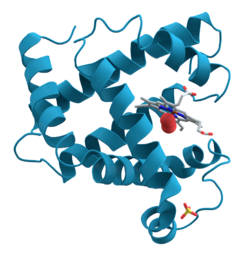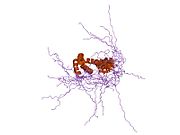Biology:PDCD5
From HandWiki
Short description: Protein-coding gene in the species Homo sapiens
 Generic protein structure example |
Programmed cell death protein 5 is a protein, originally identified as an apoptosis-accelerating protein,[1] that in humans is encoded by the PDCD5 gene.[2][3]
This gene encodes a protein expressed in tumor cells during apoptosis independent of the apoptosis-inducing stimuli. Prior to apoptosis induction, this gene product is distributed in both the nucleus and cytoplasm.
Once apoptosis is induced, the level of this protein increases and by relocation from the cytoplasm, it accumulates in the nucleus. Although its exact function is not defined, this protein is thought to play an early and universal role in apoptosis.[3]
References
- ↑ "Cellular functions of programmed cell death 5". Biochimica et Biophysica Acta (BBA) - Molecular Cell Research 1863 (4): 572–580. April 2016. doi:10.1016/j.bbamcr.2015.12.021. PMID 26775586.
- ↑ "TFAR19, a novel apoptosis-related gene cloned from human leukemia cell line TF-1, could enhance apoptosis of some tumor cells induced by growth factor withdrawal". Biochemical and Biophysical Research Communications 254 (1): 203–210. January 1999. doi:10.1006/bbrc.1998.9893. PMID 9920759.
- ↑ 3.0 3.1 "Entrez Gene: PDCD5 programmed cell death 5". https://www.ncbi.nlm.nih.gov/sites/entrez?Db=gene&Cmd=ShowDetailView&TermToSearch=9141.
Further reading
- "Club cell-specific role of programmed cell death 5 in pulmonary fibrosis". Nature Communications 12 (1): 2923. May 2021. doi:10.1038/s41467-021-23277-8. PMID 34011956.
- "ATF3 drives cell senescence through TGFβ/Pdcd5 pathway in cardiac myocyte". International Journal of Cardiology 348: 118. February 2022. doi:10.1016/j.ijcard.2021.11.067. PMID 34856292.
- "Muscle-specific programmed cell death 5 deletion attenuates cardiac aging". International Journal of Cardiology 345: 98–104. December 2021. doi:10.1016/j.ijcard.2021.10.142. PMID 34710491.
- "Normalization and subtraction: two approaches to facilitate gene discovery". Genome Research 6 (9): 791–806. September 1996. doi:10.1101/gr.6.9.791. PMID 8889548.
- "Nuclear translocation of PDCD5 (TFAR19): an early signal for apoptosis?". FEBS Letters 509 (2): 191–196. December 2001. doi:10.1016/S0014-5793(01)03062-9. PMID 11741587.
- "Exploring proteomes and analyzing protein processing by mass spectrometric identification of sorted N-terminal peptides". Nature Biotechnology 21 (5): 566–569. May 2003. doi:10.1038/nbt810. PMID 12665801.
- "The 5'-upstream region of human programmed cell death 5 gene contains a highly active TATA-less promoter that is up-regulated by etoposide". Gene 329: 39–49. March 2004. doi:10.1016/j.gene.2003.12.025. PMID 15033527.
- "Large-scale characterization of HeLa cell nuclear phosphoproteins". Proceedings of the National Academy of Sciences of the United States of America 101 (33): 12130–12135. August 2004. doi:10.1073/pnas.0404720101. PMID 15302935. Bibcode: 2004PNAS..10112130B.
- "The N-terminal 26-residue fragment of human programmed cell death 5 protein can form a stable alpha-helix having unique electrostatic potential character". The Biochemical Journal 392 (Pt 1): 47–54. November 2005. doi:10.1042/BJ20050688. PMID 16083422.
- "A human protein-protein interaction network: a resource for annotating the proteome". Cell 122 (6): 957–968. September 2005. doi:10.1016/j.cell.2005.08.029. PMID 16169070.
- "Two single-nucleotide polymorphisms with linkage disequilibrium in the human programmed cell death 5 gene 5' regulatory region affect promoter activity and the susceptibility of chronic myelogenous leukemia in Chinese population". Clinical Cancer Research 11 (24 Pt 1): 8592–8599. December 2005. doi:10.1158/1078-0432.CCR-05-0039. PMID 16361542.
- "Expression of programmed cell death 5 gene involves in regulation of apoptosis in gastric tumor cells". Apoptosis 11 (6): 993–1001. June 2006. doi:10.1007/s10495-006-6714-6. PMID 16547588.
- "Global, in vivo, and site-specific phosphorylation dynamics in signaling networks". Cell 127 (3): 635–648. November 2006. doi:10.1016/j.cell.2006.09.026. PMID 17081983.
- "Involvement of PDCD5 in the regulation of apoptosis in fibroblast-like synoviocytes of rheumatoid arthritis". Apoptosis 12 (8): 1433–1441. August 2007. doi:10.1007/s10495-007-0070-z. PMID 17468978.


